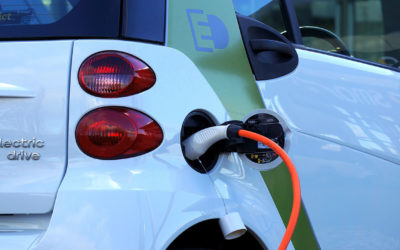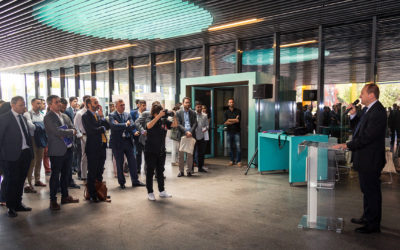Ferrovial is one of the companies that collaborated in the launch of Madrid in Motion. Since its founding in 1952, Ferrovial is a world leader in the infrastructure and services sector, where it develops solutions distinguished by innovation and sustainability. The company has more than 92,113 employees and a presence in 6 major markets, is listed on the IBEX 35 and is part of prestigious sustainability indices such as the Dow Jones Sustainability Index and the FTSE4Good.
In the field of new mobility, Ferrovial is already behind innovative initiatives in the city of Madrid, such as Zity electric carsharing or the Wondo mobility app. As a partner company of Madrid in Motion, it has participated in the first edition of the open innovation programme with a challenge relating to dynamic and connected infrastructures, with the aim of optimizing the capacity of Madrid’s infrastructures to reduce congestion and achieve smoother traffic.
In this post we interview Adrian Talbot, Head of Centre of Excellence for Mobility at Ferrovial Corporation, who gives us his vision on the future of urban mobility and the role infrastructures play in it.
Experience shows that there is no single “silver bullet” for addressing the many and varying needs of both citizens and city administrators to achieve their desired outcomes.

Adrian Talbot
Head of Centre of Excellence for Mobility at Ferrovial Corporation
How do you see the future of urban mobility?
Experience shows that there is no single “silver bullet” for addressing the many and varying needs of both citizens and city administrators to achieve their desired outcomes – which although are aligned at the highest level, often diverge when viewed at the granularity of the individual.
The movement of people and goods within cities will therefore increasingly be delivered through a multi-modal, integrated network of complementary and overlapping public and private solutions, offering a variety of choices that target different sweet spots of demand and benefit.
City administrations (or their transport authorities) will, supported by national and local regulation and policies, leverage centralized control and orchestration to manage the wider network and all public and private operators/users on the network to ensure that it is optimised towards achieving the desired strategic outcomes.
Urban mobility is also likely to expand from the current ground and underground modes of transport into the air with the advent of emergent technology that will enable sustainable solutions for flying cars and taxis.
Cost for using the network will be dynamic (based on a variety of parameters) and journey based with various options available at different price/speed/convenience points. “Journey time” guarantees and sustainability incentives will be popular mechanisms to drive behavioural change and modal shift.
What will its impact be on infrastructures? How will they have to change?
Existing and new infrastructure should be (re)designed to explicitly support multi-modal and emerging solutions. This should include integration of physical and digital infrastructure to ensure low-latency connectivity (such as 5G and Wifi) to allow dynamic, centralized orchestration and control; electric charging solutions (plug-in charge points or embedded induction loops) for all vehicles incl. buses, pods, taxis and private vehicles and docks/charging solutions for micro-mobility options such as scooters and bicycles.
The emergence of autonomous vehicles and demand responsive transit with an increase focus on “healthy” mobility such as walking, scooters and bicycles should drive a significant opportunity for a redesign of the current highway paradigm that prioritizes motorized vehicles over pedestrians and bicycles.
Future developments will be designed from the outset to favour a more balanced transport mix – and to support/enable a more rapid adoption of autonomous vehicles.
Simple solutions such as clear and well-maintained road markings, active signage, improved sight lines and managed lanes will benefit all forms of transport including pedestrian.
Increasingly, integrated transport will be reliant on real-time data coming from both the infrastructure itself as well as the vehicles and users of the network.
What about the interaction between infrastructures on one side and vehicles, drivers, passengers, pedestrians and other actors on the other? How will it be? What new services will emerge?
Real-time communication between all actors – be it infrastructure to vehicle, vehicle to infrastructure, transport authority to driver or passenger – is critical for integrated multi-modal transport networks to operate effectively. Improved technology capabilities such as high-bandwidth and low-latency communication are needed, as are new data and communication standards to improve inter-operability between different systems and providers.
Although many new services will likely emerge – some of which we can still only dream of – a number of areas are already being developed that will have a impact on how journeys are made in the future:
- Emergency vehicle prioritisation: by remote controlling the flow and position of vehicles ahead of emergency vehicles the transport authorities can ensure the safe and swift passage of emergency vehicles.
- Smart Parking: direct routing to a free parking space to avoid circulation and reduce congestion.
- Dynamic Traffic Control: a better understanding of actual road usage and conditions in real-time at junctions enables dynamic control of traffic flow at junctions to reduce congestion or to improve air-quality and/or to dynamically change signage and vehicle instructions to automatically re-route.
- Driver awareness: improved situational awareness of accidents or other issues such as road-works, pot-holes, adverse weather conditions etc.
- Managed Lanes & dynamic tolling: options for dynamically and using digital rather than pure physical infrastructure to support and manage different lanes for prioritisation of different vehicles or journey types to deliver strategic outcomes (including to incentivize behavior change).
What are the main challenges for cities?
The main challenges for city administrations relates to the need to move quickly and flexibly in the area of regulation and policy changes. Informed engagement with and sign-off for infrastructure investment to keep pace with the technology and data enabled mobility solutions is also a significant challenge.
On the one hand there is a need and desire to learn about some of these solutions (Will they be used by citizens? What are the specific dynamics both from a business and user perspective?) at the same time there is also a need to ensure that the city doesn’t lose control of the situation and allow solutions that have a detrimental impact on the wider network or make long-term investment decisions without a proper and up-to-date understanding or knowledge of the developing situation or demands of the citizens and their changing behaviours.
What is your company doing to explore the future of urban mobility?
Ferrovial is heavily engaged in the development of future mobility solutions and is investing significant resource into both innovation focused R&D and business development opportunities.
Ferrovial have active partnerships with leading academic institutions around the world and are conducting applied research programmes across a number of key areas. We are actively engaged with key innovation eco-systems and working with various partners to develop challenges through which we engage the start-up and scale-up companies actively developing mobility related solutions. We have established a Centre of Excellence for Mobility that coordinates the group’s programme of mobility related innovation projects (currently in excess of 100 activities) and is developing thought leadership in key areas of interest.
Ferrovial have also launched a number of new mobility related business lines – most notably Zity (a rapidly growing vehicle sharing partnership with Renault), Bicing (a micro-mobility service in Barcelona) and Wondo (a mobility-as-a-service solution). We also have well-established business lines (for example Toll Roads and Construction) that are evolving their current offerings to adapt to the new opportunities that Connected, Autonomous, Shared and Electric (CASE) solutions can provide.
Could you please give us an example of an initiative that you find particularly interesting? (it doesn’t matter if your company doesn’t take part in it).
Urban mobility planning at city scale is very interesting – and we are following the developments in places such as China, Singapore, New York, Madrid, London and Stockholm where large-scale deployments of different congestion charging and/or low emission zones have been deployed or are being considered often alongside a holistic approach to integrated transport planning and management.
It will be very interesting to learn from these early adopters as to what works and what doesn’t – but also to acknowledge the fact that local factors will play a significant role in the success of these initiatives.
Another area that is of great interest is how different cities approach their relationship with private providers of services such as ride-hailing, vehicle sharing and micro-mobility solutions.
A pro-active, flexible and supportive approach – but with clear policies, guidelines and licenses – seems to be the model that gives all stakeholders the right balance of opportunity and control to benefit both in the short and longer term. City administration supported challenges, accelerators and “living lab” initiatives (Such as “Madrid in Motion”) are an excellent mechanism through which a lot of this learning and scale-up can be delivered in partnership between public administrations and private enterprises and start-ups.


